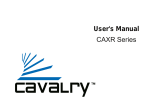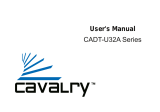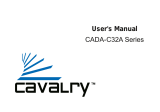Page is loading ...

User's Manual
CAND Series

2
Dear Valued Customer:
Thank you for choosing Cavalry Storage.
We at Cavalry extend our sincere gratitude for your purchase of this product. We hope our
dedication to delivering high quality products with excellent customer service will ensure your
continued interest in our products.
This manual will assist you in the operation of the product. To optimize your experience with
this product, we recommend reading this entire manual before usage. Please keep this manual
for future reference.
Kind regards,
Cavalry Storage Inc.

3
Table of Contents
Preface………………………………………………………………………….. 4
Conventions & Safety Instructions…………………………………………….. 5
Accessories List………………………………………………………………… 6
Features………………………………………………………………………… 6
Product Illustrations……………………………………………………………. 7
Quick Start Guide……………………………………………………………… 9
Web-based GUI………………………………………………………………… 21
Accessing Instructions………………………………………………... 23
DiskTools Tab………………………………………………………… 23
RAID Setting.……………………………………………….. 23
Basic Mode………………………………………………….. 23
Disk Usage…………………………………………………... 24
System Tab……..…………………………………………………….. 25
Information…….……………………………………………. 25
LAN Settings………………………………………………… 25
Time Settings……...…………………………………………. 25
Save Configuration……..…………………………………… 26
Restore Configuration..……………………………………… 26
Firmware Upgrade…………………………………………... 26
Install Software……………………………………………… 27
Email Notification…………………………………………… 29
Turn Off Server……………………………………………… 29
Account Tab…………………………………………………………... 30
User Management…………………………………………… 30
Share Management………………………………………….. 31
Group Management…………………………………………. 32
Server Tab…………………………………………………………….. 34
File Server…………………………………………………… 34
DHCP Server………………………………………………… 34
Printer Server………………………………………………… 34
Bonjour………………………………………………………. 35
Backup Tab……………………………………………………………. 38
Backup Scheduling…………………………………………… 38
Scheduling Task……………………………………………… 39
LogFiles Tab…………………………………………………………… 40
Logout Tab…………………………………………………………….. 40
Troubleshooting…………………………………………………………………. 41
Contact…………………………………………………………………………... 43

4
Preface
Copyright
Please respect copyrighted content. Duplication or modification of this publication in part or in
whole is prohibited without expressed or written authorization.
Usage
Strong impacts or dropping of the product may cause damage. Only allow qualified personnel to
repair this product. Disassembling or opening this product will void your warranty.
Disclaimer
Cavalry is not liable for compensation for data loss which may result from a malfunction of the
product or from changes due to improper use, repairs, defects, or battery change. Please back
up your data to avoid unexpected losses. Cavalry reserves the right to make changes to the
content of this manual without notice. The most current manuals and software are available for
download at our download page: www.cavalrystorage.com/su_download.htm

5
Conventions & Safety Instructions
CAUTON This symbol is to remind the user to pay attention and read carefully.
Failure to do so could result in data loss.
Note This symbol is used to provide the user with useful information.
Please read through this entire manual and save for future reference.
Place the NAS in a secure location free from the possibility of being bumped
and/or dropped.
Do not place the unit near a radiator or other hear source.
Do not use the unit near water.
Gaps and opening on the outer casing are intended to provide airflow. Never block
or cover these openings as doing so may cause the unit to overheat and become
unreliable during operation.
The unit must be grounded. The NAS is equipped with a 3-wire, grounded power
cord.
Do not place the unit where the cord could be walked on.
Unplug the power cord from the wall outlet before cleaning. Be sure to keep the
unit dry. Do not use liquid cleaners, aerosol cleaners, or a wet cloth to clean the
unit.
Do not remove the back panel of the unit as it will void your warranty.

6
Accessories List
1. Ethernet cable
2. Power adapter / power cord (images may vary with product)
3. Resources CD
Features
Network Attached Storage (NAS)
Supports 10/100/100 Mbps LAN Speed
Printer server capability with USB 2.0
Supports RAID 0 & 1, Spanning, and JBOD
RAID 1 preconfigured
Supports FTP/SMB server
Supports UPnP Protocol
Supports ext 2, ext 3, FAT32 (JBOD only) formatting
Exceptional heat dissipating ability with 2.5” fan
LED activity indicators
Nearly silent operation
PC, Mac and Linux compatible

7
Product Illustrations
Package Contents

8
Front
Rear

9
Quick Start Guide
Note: For optimal security and convenience, we recommend designating a single computer to
handle all NAS configurations. Items in BOLD are included in your package contents.
1.) Connect your power adapter to the NAS. Then plug the adapter into an electrical
outlet. Turn on the power; the “Power” LED will light up to indicate the unit is on.
2.) Insert the Ethernet cable to the LAN port on the back of the CAND and the other
end to an Ethernet port on the network adapter of a router/switch/hub. The “Link”
LED will illuminate to indicate connection (See page 8).
3.) Map/Mount your CAND to your computer.
Windows XP Users
a. On your XP desktop, click “Start” and then “My Network Places”.
b. Click on “Entire Network”.

10
c. Double-click “Microsoft Windows Network” >> “Workgroup” >> “Storage
(Giganas)”
d. Right-click “public” and select “Map Network Drive…”
e. Specify the drive letter that you want for your NAS and then click “Finish”.
Your NAS will now show up under “My Computer” in the “Network Drives”
section.
Windows Vista Users

11
a. On your Vista desktop, click “Start” and “Network”.
b. The “Network” window will pop-up showing your current network locations.
Vista will display your networks hard drives in the window. Find your NAS
which should be named “Nas” or “Giganas” and double-click.

12
c. A smaller window will pop-up and ask for authentication for access to the
CAND. Enter username: “admin” and password: “admin”.
d. The NAS’ window will show. Double-click on the “public” folder.

13
e. Click on the top address bar in the area as shown below and highlight the
path to your NAS.
f. With the path to your NAS still highlighted, right-click anywhere on the blue
highlighted area. Select “Copy”.
g. Double-click the “Computer” icon on the desktop or click “Start” and the
“Computer” to open the “Computer” window.

14
h. Click on the top menu, “Map network drive” to start the Map network drive
wizard.

15
i. Select the drive letter you wish the mapped network drive to have. Press
the down-arrow next to “Drive:” as shown. The pull-down menu will show
the available drive letters to choose from. In this example, “N:” was chosen.
j. Right-click inside the “Folder” textbox. A pop-up menu should appear. Left-
click “Paste” to paste the network path we copied in step “f.” of this section.
This path will be mapped as our new network drive with the drive letter you
just pasted.
k. The wizard should now like below. Make sure the “Reconnect at logon” box
is checked so that next time you restart, the mapped network drive will still
be available as long as your CAND is still turned on. Click “OK” to finish the
wizard.

16
l. You should be able to see the drive normally. You can access it by
accessing the “Computer” icon.
Mac OS X 10.4/10.5 Users
a. While on your Mac OS X desktop, go to the top menu “Go” and select
“Network”.
b. The NAS is preset to show up in a workgroup called “Workgroup”. Double-
click “Workgroup”.

17
c. Double-click on the name of the drive that represents your NAS (normally
Giganas or NAS).
d. A small window will pop up giving you an option of which folder you would
like to connect to on the NAS. Click on the “double up-down arrow” icon to
open the pull-down menu.

18
e. Select “public” and click “OK”.
f. Click “OK”.

19
g. Enter the name: “admin” and password: “admin”. Click “OK”.
h. Now you can click on the “Public” icon on the left to access your NAS or
you can click on the “Public” icon on your desktop.

20
4.) To setup the NAS to be accessible on other computers in your home network,
simply repeats step 3 for each additional computer.
5.) You are now ready to transfer files to and from your NAS!
/


